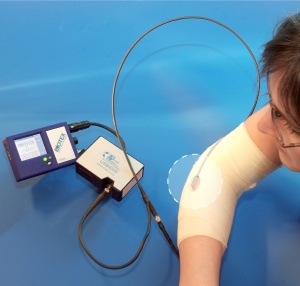Jul 5 2008
Biosensors are capable of measuring the healing process of wounds. Their integration in wound dressing materials or other medical textiles opens up new and cost-effective perspectives in patient care. In a European project directed by the CSEM Centre Suisse d'Electronique et de Microtechnique SA (CSEM), intensive research is being conducted in this area. The sixth NanoEurope, which will be held in St.Gallen (Switzerland) on September 16 and 17, 2008, will present this application and other innovations from the field of nanotechnology to the interested specialist public.
 Continuous and localized monitoring of wound healing
Continuous and localized monitoring of wound healing
A biosensor uses biological parameters to detect changes in its environment. In brief, it converts a biological response into an electrical signal. A number of biosensors are available in the market-place today, for example the glucose biosensor for determining the level of sugar in the blood of diabetics. Research efforts are now focusing on biosensors which can be integrated in wound dressing materials and other medical textiles, which will monitor the wound healing process.
Safer, simpler, more cost-effective
Sensors capable of measuring the health condition of patients on the basis of certain criteria allow continuous monitoring of the healing process. Any irregularities are detected at an early stage. Applied to ambulatory healthcare, convalescent persons, or patients with chronic diseases, this method of monitoring reduces costs and increases the safety and comfort of the people affected.
CSEM in Neuchâtel heads the European "Biotex" project, whose goal is to develop wearable bio-sensors for measuring wound healing. The biosensor is integrated in the wound dressing and tests two quantities: the pH value indicating the acidity of the wound, and the CRP protein measuring the degree of inflammation. This enables the status of wound healing to be checked and acute inflam-mations to be detected at an early stage. Alarm signals are triggered quickly without requiring the removal of the dressing from the wound, which greatly reduces the risk of infections.
Remote wound monitoring offers large benefits not only for skin grafts or ulcer treatments, but generally allows more exact and comprehensive ambulatory monitoring. These developments are now being extended to other fields, such as for assisting people in extreme situations, for instance fire-fighters.